FORWARD NM Pathways to Health Careers
- Need: New Mexico's southwestern counties of Hidalgo, Catron, Luna, and Grant have experienced chronic shortages of primary care providers. New Mexico has the oldest physician population in the country.
- Intervention: A comprehensive workforce pipeline program, including programming for middle and high school students, undergraduate and graduate students, primary care program students, and medical and dental residents.
- Results: The program reaches over 1,000 school-aged students throughout the service areas and provides support for students and medical residents in a variety of healthcare-related programs for rural rotation experiences. FORWARD NM received its designation as an Area Health Education Center (AHEC) in 2012.
Description
New Mexico's Hidalgo, Luna, Catron and Grant counties, located in the southwest corner of the state, have experienced ongoing and severe shortages of primary care providers. The average age of the state's physician workforce is 53, and one-third of the state's physicians are over 60 years of age. The number of practitioners retiring soon far exceeds the number of new graduates ready to take their places. To help improve and ensure access to primary care in this rural area, the Center for Health Innovation began FORWARD NM to lead a range of activities under the "Grow-Your-Own" model of care through its Pathways to Health Careers pipeline.
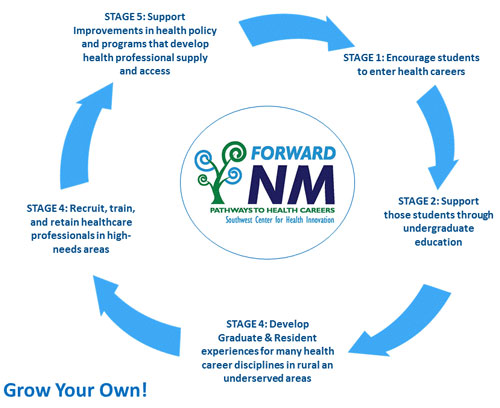
The following organizations partner with FORWARD NM:
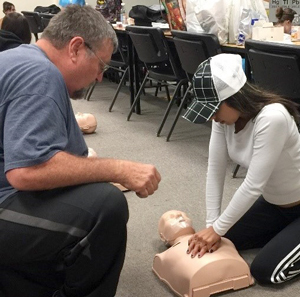
- The University of New Mexico
- Western New Mexico University
- Gila Regional Medical Center
- Southern New Mexico Family Medicine Residency Program
- Arizona School of Dentistry & Oral Health
- University of Arizona
- Northern Arizona University
- Other AHEC Centers in New Mexico: Southern Area Health Education Center (SoAHEC) and Montanas del Norte (MdN AHEC)
- Several other universities and colleges that prepare individuals for a career in the healthcare sector on a national and international level
- All regional school districts
- Community healthcare providers
The project was previously supported by a 2010-2013 Federal Office of Rural Health Policy Rural Health Workforce Development grant through the New Mexico Department of Health grants, sub-contracted with the University of New Mexico Area Health Education Center (AHEC) program and local foundations.
Services offered
Services provided by the FORWARD NM program cover the entire healthcare workforce pipeline and help recruit and retain rural providers:
Dream Makers Health Career Clubs – Educates students on different healthcare professions through field trips, hands-on participation, and interaction with professionals. The program is sponsored by the University of New Mexico.
Team Academy for Health Sciences (TAHS) – A 3-week summer academy for high schoolers. It provides healthcare career and college exploration, classes that qualify for college credit, and tours of regional health centers.
Health Career Manual – A free, downloadable guide to help students discover what health career paths might suit their talents and how to achieve that future.
College Application & Scholarship Support – Program staff meet with students interested in a healthcare career to formulate a plan to fulfill their goals. Areas include application completion, scholarships and loans, writing support, and mock interviews.
Advocacy – Program staff work to support state and federal policies aimed at obtaining an adequate rural primary care access and workforce. The program introduces students interested in medicine to the University of New Mexico Combined BA/MD program for a medical-focused higher education path. Supports rural training experiences during medical, dental, and behavioral school and residency programs.
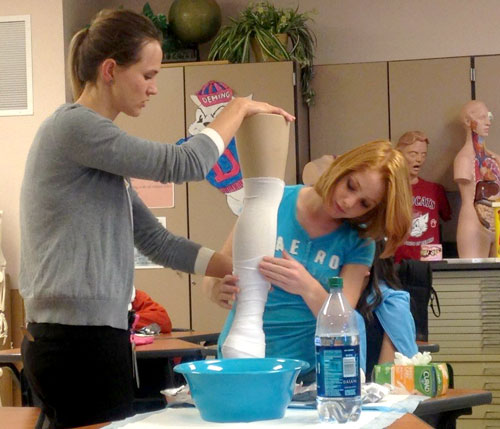
Results
FORWARD NM has accomplished the following:
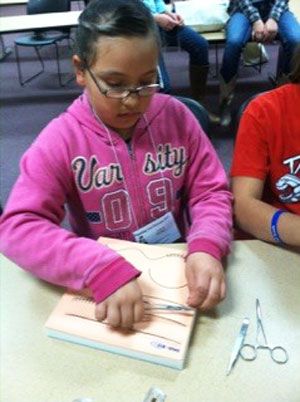
- Worked with middle and high school students throughout the four counties, reaching more than 1,000 students in FY21
- Hosted more than 5,000 rural rotation experiences since its start in 2012 for medical, dental, and behavioral health students and residents of more than 25 disciplines in healthcare at more than 15 different colleges and universities
- In 2012, FORWARD NM received accreditation as an Area Health Education Center (AHEC)
The article One Month Rural, published in The Differential, was written by University of Arizona Second Year Medical Student Michelle Blumenschine. The article explains her experience during a clinical rural rotation at Hidalgo Medical Services, coordinated by FORWARD NM, in 2015.
Challenges
In recent years, AHEC funding has been stable and adequate to support FORWARD NM's pipeline programs and activities. The center has faced the challenge of reaching students amid the COVID-19 pandemic.
Replication
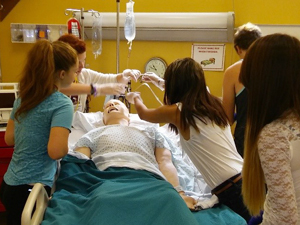
FORWARD NM Pathways to Health Careers and its components are replicable and adaptable to similar environments and communities. FORWARD NM developed a Toolkit that can assist in adapting parts or the entire model as applicable and necessary in other environments and communities.
Contact Information
Bala Salgado, Director of FORWARD NM Area Health Education CenterCenter for Health Innovation
575.597.0030
forwarndnm@chi-phi.org
Topics
Federally Qualified Health Centers
· Graduate medical education
· Health workforce pipeline
· Recruitment and retention of health professionals
· U.S.-Mexico Border Region
States served
New Mexico
Date added
May 30, 2013
Suggested citation: Rural Health Information Hub, 2022 . FORWARD NM Pathways to Health Careers [online]. Rural Health Information Hub. Available at: https://www.ruralhealthinfo.org/project-examples/724 [Accessed 6 January 2026]
Please contact the models and innovations contact directly for the most complete and current information about this program. Summaries of models and innovations are provided by RHIhub for your convenience. The programs described are not endorsed by RHIhub or by the Federal Office of Rural Health Policy. Each rural community should consider whether a particular project or approach is a good match for their community’s needs and capacity. While it is sometimes possible to adapt program components to match your resources, keep in mind that changes to the program design may impact results.
